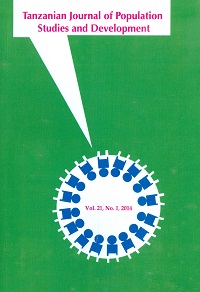Is Condom Use Safe? Youth Perceptions on the Use of Condoms In Muleba, Handeni and Ludewa Districts, Tanzania
Abstract
This article attempts to explain youth perceptions on condom use. For more than thirty years since the onset of HIV/AIDS in Tanzania, condom is still regarded as one of the three preventive measures against HIV infection. The other two are abstinence and faithfulness to one un-infected partner, referred shortly as ABC. Available evidence shows that despite continued efforts to campaign for condom use during sexual intercourse, its use has been low. The article addresses this mismatch between the rate of awareness and knowledge about HIV and low rate of condom use among the youth, and how youth perceptions leads to this discrepancy. This article used data collected between 2007 and 2008 through survey questionnaire and focus group discussions (FGDs) in three districts of Muleba, Handeni and Ludewa districts. The finding shows that youth ' s awareness and knowledge on HIV/AIDS and how one gets infected with the virus was high, to about 91%. Awareness on where to obtain condoms was 76%. However, despite this high rate of awareness the use of condom by youth was low, to about 33%: Ludewa recorded the lowest rate of (7%), followed by Muleba (12%), and Handeni (14%). The discrepancy was attributed to youth perceptions on the ability of condom to protect against HIV infection. Most youth do not use condom during sex and treat condom with suspicion. The article recommends an increased campaign on the use of condom, focusing on this category of the population and addressing cultural challenges on issues related to sex that youth are subjected to.
References
Ajzen, I. 2002. Perceived Behavioural Control, Self Efficacy, Locus of Control and the Theory of Planned Behaviour. Journal of Applied Social Psychology, 32: 665 €“683.
€”. 1988. Attitudes, Personality and Behaviour. Milton Keynes: Open University Press.
€”. 1991. The Theory of Planned Behaviour. Organizational Behaviour and Human Decision Processes, 50: 179-211.
Bourdieu, P. 1984. Distinction: A Social Critique of the Judgement of Taste. Trans. R. Nice. London: Routledge.
Burke, P. 2009. Cultural Hybridity. Cambridge: Polity Press.
Eagly, A. H. & S. Chaiken. 1993. The Psychology of Attitudes. Fort Worth: Harcourt Brace College Publishers.
Hunter, L. K. 1998. Condom Use of Female College Students as a Function of Information Versus Role Play and Modeling. MA Theses, University of the Pacific.
Kitula, M. & T. Ndaluka. 2014. Cultural Factors Influencing Youth Attitudes on the Use of Condoms in Fighting Against HIV Infection In Tanzania. Research Paper, Repoa; Dar es Salaam.
Mohsw. 2004a. Behavioural Surveillance Survey among Youths. A Report. Ministry of Health and Social Welfare (MOHSW), Dar es Salaam
€”. 2004b. National Essential Health Sector HIV and AIDS Intervention Package. Ministry of Health and Social Welfare (MOHSW), Dar es Salaam.
Moshi, S. J. 2003. Knowledge, Perception, Attitude And Practice of Safe Sex Among Youth In Moshi Rural District, Kilimanjaro Region. A Dissertation in Fulfilment of MA €“ Public Health, University of Dar es Salaam.
NACP. 2004. HIV/AIDS/STI Surveillance Report: January €“December 2003.
National AIDS Control Program (NACP), Dar es Salaam; Report No. 18.
€”. 2005. HIV/AIDS/STI Surveillance Report of From January €“December 2004. National AIDS Control Program (NACP), Dar es Salaam, Report No. 19.
Odirile, L. W. 2000. Knowledge, Attitude and Beliefs among University of Botswana Undergraduate Student. PhD Dissertation, Ohio University.
United Republic of Tanzania (URT). 2013. Tanzania HIV/AIDS And Malaria Indicator Survey 2011-12. National Bureau of Statistics, Tanzania AIDS Commission, Zanzibar AIDS Commission, ICF International.


